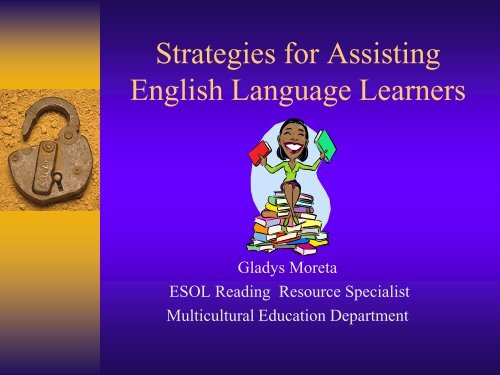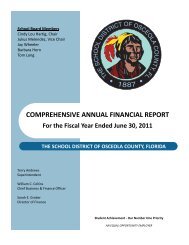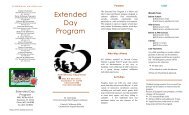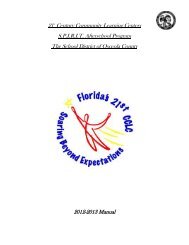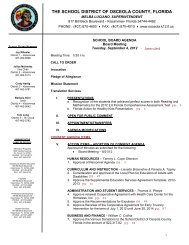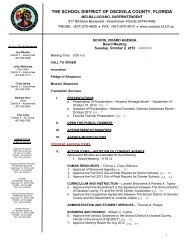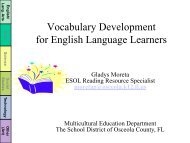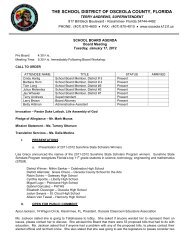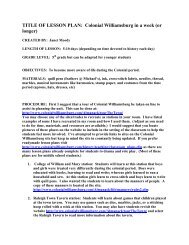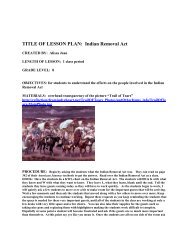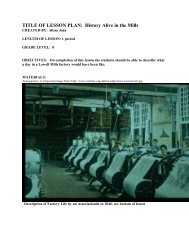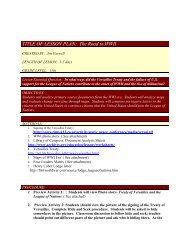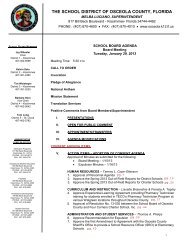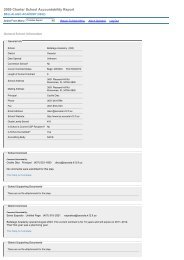Strategies for Assisting English Language Learners
Strategies for Assisting English Language Learners
Strategies for Assisting English Language Learners
Create successful ePaper yourself
Turn your PDF publications into a flip-book with our unique Google optimized e-Paper software.
<strong>Strategies</strong> <strong>for</strong> <strong>Assisting</strong><br />
<strong>English</strong> <strong>Language</strong> <strong>Learners</strong><br />
Gladys Moreta<br />
ESOL Reading Resource Specialist<br />
Multicultural Education Department
WORKSHOP DESCRIPTION<br />
This workshop will provide participants with<br />
strategies on how to best meet the needs of<br />
<strong>English</strong> <strong>Language</strong> <strong>Learners</strong> during the 90<br />
minutes of Reading Instruction.
OBJECTIVE<br />
Provide best practices to ensure<br />
comprehensible instruction to <strong>English</strong><br />
<strong>Language</strong> <strong>Learners</strong> according to their<br />
language level and ability.
AGENDA<br />
<strong>Language</strong> Acquisition vs. <strong>Language</strong> Learning<br />
Understanding <strong>English</strong> <strong>Language</strong> <strong>Learners</strong><br />
Setting up the Learning Environment<br />
Reading To, With and By Children<br />
Thematic Planning<br />
Read Aloud<br />
Shared Reading<br />
Guided Reading Groups<br />
Centers
RESEARCH SAYS…..<br />
Children master a second language best if it<br />
is introduced by age 10.<br />
Learning a second language enhances a<br />
child's understanding of his or her native<br />
language<br />
Second language instruction at an early age<br />
improves a child's overall academic<br />
per<strong>for</strong>mance in school.<br />
Learning a second language improves a<br />
child's cognitive ability.
LANGUAGE ACQUISITION<br />
This is a subconscious ef<strong>for</strong>tless process that occurs<br />
without people actually realizing that it is occurring. It<br />
is what children do when learning to speak their first<br />
language.<br />
<strong>Language</strong> acquisition usually occurs in a non-stressful<br />
environment with ample visual support and<br />
rein<strong>for</strong>cement. For students learning <strong>English</strong> as a<br />
Second <strong>Language</strong>, this is what we refer to as<br />
BICS, or Basic Interpersonal Communication Skills.<br />
It is the language skills necessary to communicate basic<br />
needs and wants. These language skills usually<br />
develop within six months to two years.
LANGUAGE LEARNING<br />
This is what usually occurs in school. It is an overt and<br />
conscious process. When people are learning, they<br />
are aware they are learning because they are<br />
participating in the process. There<strong>for</strong>e, it must be<br />
explicitly taught.<br />
This learned academic language, is the kind of<br />
language needed <strong>for</strong> tasks such as comprehension of<br />
text, analysis, and synthesis.<br />
For students learning <strong>English</strong> as a Second <strong>Language</strong>,<br />
this is what we refer to as CALP, or Cognitive<br />
Academic <strong>Language</strong> Proficiency.
STAGE I PRE-PRODUCTION<br />
(NEWCOMER)<br />
0-8 MONTHS<br />
Student – No comprehension or<br />
speaking abilities in second language.<br />
What learner can do - Point to an<br />
object, picture or person, Follow<br />
commands (stand up, open the door).<br />
Gesture or nod (to show agreement or<br />
disagreement) Say yes or no.
TEACHER ROLE FOR STAGE I<br />
Teacher – Use of gestures to communicate.<br />
– Show me….<br />
– Circle the….<br />
– Where is…<br />
– Who has…<br />
Teaching <strong>Strategies</strong> - Total Physical<br />
Response Activities, Listening<br />
comprehension activities. Build Receptive<br />
Vocabulary, Much repetition of <strong>English</strong>.<br />
Create climate of acceptance/respect that<br />
supports acculturation.
Stage II Early Production<br />
(Low Beginner)<br />
2-12 months<br />
Student – Begins to understand/produce<br />
simple responses in second language<br />
What learner can do - Answer questions<br />
with 1 word (Is the box big or little? –<br />
Big) Put 2 or more words together<br />
(small square) Use repetitive language<br />
patterns (My name is Lucy. I like pizza.)
TEACHER ROLE FOR STAGE II<br />
Teacher – Communicates with simple<br />
questions.<br />
Teaching <strong>Strategies</strong> - Ask yes/no and<br />
either/or questions. Accept one or two<br />
word responses. Use pictures and realia<br />
to support questions. Simplify the<br />
content materials to be used focusing<br />
on key vocabulary and concepts.<br />
Support learning with graphic<br />
organizers, charts, and graphs.
Stage III Speech Emergence<br />
(Beginner)<br />
6 months – 2 years<br />
Student – Understands more of the<br />
second language and communicates in<br />
phrases.<br />
What learner can do - Use 3 more<br />
words and short phrases (Stand up, We<br />
go park.)Use beginning dialog. Use full<br />
simple sentence. (There are four<br />
pencils.)
TEACHER ROLE FOR STAGE III<br />
Teacher – Models correct language<br />
<strong>for</strong>ms.<br />
Teaching <strong>Strategies</strong> - Read to and allow<br />
learner to read short, modified text in<br />
content area subjects. Model<br />
completing graphic organizers with word<br />
banks. Duet, choral and pair reading<br />
activities. Match vocabulary words to<br />
definitions. Two step directions.
Stage IV Intermediate Fluency (Intermediate)<br />
After about 2 years<br />
Student – Understands and produces<br />
connected narrative in second<br />
language.<br />
What learner can do - Use complex<br />
language (I want to learn about animals<br />
that live in Africa.)State opinions (I think<br />
this food is too spicy.)Speak at length.<br />
Ask <strong>for</strong> clarification (What is the<br />
difference between a plan and a<br />
plateau?)Share original thoughts.
TEACHER ROLE FOR STAGE IV<br />
Teacher – Models correct language<br />
<strong>for</strong>ms.<br />
Teaching <strong>Strategies</strong> - Allow learner to<br />
use strategies from their native<br />
language to learn content in <strong>English</strong>.<br />
For example: using cognates (hospital)<br />
same word in Spanish and <strong>English</strong>.<br />
Synthesize what they have learned and<br />
make inferences from their learning.<br />
Focus on learning strategies.
Stage V Advanced Fluency<br />
(Advanced)<br />
After about 5 to 7 years.<br />
Monitoring Stage (LF) Most ELLs at this stage<br />
have been exited from ESOL services. They<br />
still need support from classroom teachers<br />
especially in content areas and writing.<br />
Learner is able to produce as long as<br />
accommodations are provided as needed.<br />
Comprehensive use of all the strategies<br />
should be implemented to assure<br />
comprehensible instruction delivery.
USE PRIMARY LANGUAGE<br />
Provide as many opportunities <strong>for</strong> them to<br />
share. (Ex. Daily News, Morning Buzz,<br />
etc.)<br />
Reading – Allow them to write their notes<br />
in their native language and then translate<br />
into <strong>English</strong> with the help of a dictionary<br />
and any other resource.<br />
Writing – Allow them to write their stories<br />
in their native language and then use a<br />
dictionary or any other resource to translate.
CREATE A PRINT-RICH,<br />
INCLUSIVE LEARNING<br />
ENVIRONMENT<br />
It is important to help every child feel welcome<br />
and an important part of the classroom.<br />
Provide children with the opportunity to read and<br />
revisit the ideas discussed over and over again.
Print Rich Environment<br />
Word Walls<br />
Charts<br />
Graphic Organizers<br />
Displays of topics/themes being taught<br />
Charts that focus on effective reading<br />
strategies, academic vocabulary and<br />
language patterns.<br />
Student work display<br />
Extensive libraries and research materials
APPROACHES<br />
Immersion<br />
Expectation/Responsibility<br />
Approximation<br />
Demonstration<br />
Feedback<br />
Employment
IMMERSION<br />
They need to be surrounded by an<br />
environment that is rich in spoken and<br />
written language.<br />
– Oral <strong>Language</strong><br />
– Drama/Role Play<br />
– Flow Chart<br />
– Illustrations<br />
– Concept Mapping<br />
– Labeling Classroom
EXPECTATION<br />
Children need opportunities to try reading and<br />
writing activities on their own.<br />
They need to be an environment where adults<br />
believe that they will acquire literacy skills.<br />
– Simplified Directions<br />
– Chart Progress<br />
– Discover Learning<br />
– Modify Assignments<br />
– Multiple Methods of Evaluation<br />
– Reading Logs
APPROXIMATION<br />
<strong>Learners</strong> must be free to approximate<br />
desired study, as mistakes are essential <strong>for</strong><br />
learning to occur.<br />
– Multiple Methods of Evaluation<br />
– Modify Assignments<br />
– Chart Progress<br />
– Dialogue Journal<br />
– Repetition/Rephrasing<br />
– Use of student’s cultural background &<br />
experiences
DEMONSTRATION<br />
Children need opportunities to observe models of the way<br />
written language is used in daily life.<br />
– Compare/Contrast<br />
– Dialogue Journal<br />
– Experiments<br />
– Flow Chart<br />
– Maps/Photos<br />
– Cognates<br />
– Questionnaires/Interview<br />
– Thematic Approach<br />
– Real Literature<br />
– Realia
FEEDBACK<br />
<strong>Learners</strong> must receive relevant, appropriate,<br />
timely, nonthreatening feedback from<br />
knowledgeable people on their attempts.
EMPLOYMENT<br />
<strong>Learners</strong> need time and opportunity to use and practice new learning in<br />
realistic ways.<br />
They need to use reading and writing skills throughout their daily<br />
lives.<br />
– Centers<br />
– Cooperative Learning<br />
– Discover Learning<br />
– Experiments<br />
– Games<br />
– <strong>Language</strong> Experience Approach<br />
– Problem Solving<br />
– Peer Tutoring<br />
– Questionnaires/Interview<br />
– Researching
SIX STRATEGIES<br />
FOR TEACHING<br />
ENGLISH LANGUAGE<br />
LEARNERS
Strategy 1<br />
Vocabulary & <strong>Language</strong> Development<br />
Content Knowledge<br />
– Introduce new concepts via essential academic<br />
vocabulary.<br />
– Connect student-accessible synonyms or<br />
concepts to these essential vocabulary.<br />
– Support students to distinguish word meanings,<br />
& their uses <strong>for</strong> subject-specific tasks.
Academic <strong>Language</strong><br />
– Engage beginning-level students in using basic<br />
social and school vocabulary, phrases, and<br />
sentence structures.<br />
– As students progress, continue to contextualize<br />
instruction of more complex language <strong>for</strong>ms<br />
and uses: subject-specific academic<br />
vocabulary, grammatical <strong>for</strong>ms, and sentence<br />
structures used in listening, speaking, reading<br />
and writing.<br />
– Respectfully distinguish between primary<br />
language use and standard academic <strong>English</strong>.
Sample activities/assessments<br />
– Word analysis: e.g., dissecting words into their<br />
parts (prefix, root, suffix)<br />
– Vocabulary journals, A-B-C books, word webs,<br />
word walls.<br />
– Interactive editing, Cloze paragraphs,<br />
dictations, subject-specific journals.
Strategy 2<br />
Guided Interaction<br />
Content Knowledge:<br />
– Structure multiple opportunities <strong>for</strong> peer-topeer<br />
interactions as they learn content and<br />
develop their use of academic language in<br />
speaking/listening, reading and writing.<br />
– Clarify expectations, outcomes and procedures<br />
related to tasks <strong>for</strong> flexible group activities.<br />
– Allow <strong>for</strong> primary language interactions to<br />
clarify concepts.
Academic <strong>Language</strong>:<br />
– Structure multiple opportunities <strong>for</strong> peer-topeer<br />
interactions to increase speaking, listening,<br />
reading comprehension and writing skills.<br />
– Support language interactions with<br />
review/preview of language <strong>for</strong>ms, use of<br />
graphic organizers or other types of modeling.
Sample activities/assessments<br />
– Partner interviews. Class surveys, Tea party,<br />
Think-Pair-Share, Numbered Heads Together,<br />
Four Corners<br />
– Poster projects, group presentations<br />
– Perspective line-ups.<br />
– Readers’ Theater
Strategy 3<br />
Metacognition and Authentic<br />
Assessment<br />
Content Knowledge:<br />
– Teach students processes <strong>for</strong> metacognition:<br />
i.e., pre-reading and pre-writing skills, word<br />
analysis, and methods to monitor their reading<br />
comprehension.<br />
– Teach and model ways <strong>for</strong> students to describe<br />
their thinking processes verbally and in writing.<br />
– Use a variety of activities and tasks to check <strong>for</strong><br />
understanding.
Academic <strong>Language</strong>:<br />
– In addition to components previously listed,<br />
ensure that assessment tasks are appropriate to<br />
students’ assessed language development level.<br />
– Provide enough time to complete tasks,<br />
appropriate feedback, rubrics, and models to<br />
guide students’ self-assessment.
Sample activities/assessments:<br />
– Guided reading, completing chapter pre-reading<br />
guides, reciprocal teaching, Directed Reading<br />
Thinking Activity (DRTA), Anticipation<br />
Guides, double-entry journals.<br />
– Think-alouds, K-W-L.<br />
– Learning logs/journals, quick-writes
Strategy 4<br />
Explicit Instruction<br />
Content Knowledge:<br />
– Teach essential grade-level concepts and build<br />
students’ background knowledge as needed.<br />
– Connect overarching ideas (whole), then<br />
examine components or processes (part),<br />
culminating with students’ own application or<br />
synthesis of ideas (new whole).<br />
– Explicitly teach academic language and<br />
cognitive reading skills needed to complete<br />
subject-specific tasks, e.g., analyze, interpret,<br />
classify, compare, synthesize, persuade, solve.
Academic <strong>Language</strong>:<br />
– Teach essential language <strong>for</strong>ms and uses per<br />
students’ assessed language development level:<br />
listening/speaking, reading and writing.<br />
– Follow contextualized introduction and explicit<br />
modeling of language use with repeated<br />
practice.
Sample activities/assessments:<br />
– Quick-write responses or recording student<br />
responses to visuals, current event stories, reallife<br />
models, video clips, teacher read-alouds,<br />
thematic prompts, role-play, comparing<br />
language uses <strong>for</strong> similar contexts.<br />
– Identifying and analyzing different perspectives<br />
and language references re: essential concepts.
Strategy 5<br />
Meaning-Based Context and Universal<br />
Themes<br />
Content Knowledge:<br />
– Introduce new concepts through familiar<br />
resources, prompts, visuals, or themes.<br />
– Use associated types of “realia” meaningful or<br />
familiar to students to affirm the appropriate<br />
context <strong>for</strong> using new language.<br />
– Sustain motivation to learn challenging<br />
concepts by linking ideas to resources or<br />
contexts that reflect student interests and sociocultural<br />
or linguistic backgrounds.
Academic <strong>Language</strong>:<br />
– Use methods previously mentioned <strong>for</strong><br />
introducing academic vocabulary, sentence<br />
structures and language uses.<br />
– Link ongoing language practice or tasks to both<br />
school-based and community-based uses.<br />
– Respectfully compare and analyze language<br />
use, and meanings to other cultures or context,<br />
to promote metacognition.
Sample activities/assessments:<br />
– Quick-write responses or recording student<br />
responses to visuals, current event stories, reallife<br />
models, video clips, teacher read-alouds,<br />
thematic prompts, role-play, comparing<br />
language uses <strong>for</strong> similar contexts.<br />
– Identifying and analyzing different perspectives<br />
and language references re: essential concepts.
Strategy 6<br />
Modeling, Graphic Organizers, &<br />
Visuals<br />
Content knowledge:<br />
– Model how to complete tasks.<br />
– Provide graphic organizers and meaningful<br />
visuals to support students’ recognition of<br />
essential in<strong>for</strong>mation.<br />
– Use graphic organizers to support<br />
understanding of specific tasks, and specific<br />
uses of academic language.<br />
– Use advanced organizers to support<br />
metacognition, and overall comprehension.
Academic <strong>Language</strong>:<br />
– Use methods listed above with the addition of<br />
word banks, word walls, and modeling the use<br />
or graphic organizers appropriate to students’<br />
level.<br />
– Appropriately modulate language delivery, i.e.,<br />
speed and enunciation, when modeling<br />
language <strong>for</strong>ms or presenting content; repetition<br />
helps.
Sample activities/resources:<br />
– Venn diagrams, story maps, main idea and<br />
supporting details schematics, double-entry<br />
journals, semantic attribute matrices.<br />
– Jazz chants, read-alouds.
Overall Strategy<br />
Work on word selection with Preproduction<br />
students.<br />
Model <strong>for</strong> Early Production students.<br />
Expand what Speech Emergence students<br />
have said or written.<br />
Help Intermediate and Advanced Fluency<br />
students “sound like a book.”
Thank You!!


